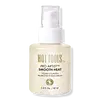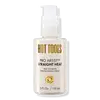What's inside
What's inside
 Key Ingredients
Key Ingredients

 Benefits
Benefits

 Concerns
Concerns

 Ingredients Side-by-side
Ingredients Side-by-side

Water
Skin ConditioningCicer Arietinum Seed Extract
Skin ConditioningCetearyl Alcohol
EmollientGlycerin
HumectantIsododecane
EmollientBehenamidopropyl Dimethylamine
EmulsifyingSalvia Hispanica Seed Extract
EmollientAvena Strigosa Seed Extract
Skin ConditioningNicotiana Benthamiana Hexapeptide-40 Sh-Polypeptide-47
Skin ConditioningTrehalose
HumectantNeopentyl Glycol Diheptanoate
EmollientLactic Acid
BufferingLecithin
EmollientEthyl Linoleate
EmollientSynthetic Fluorphlogopite
Ethyl Oleate
EmollientEthylhexylglycerin
Skin ConditioningPentylene Glycol
Skin ConditioningBenzyl Alcohol
PerfumingMica
Cosmetic ColorantTin Oxide
AbrasivePhenoxyethanol
PreservativeParfum
MaskingTitanium Dioxide
Cosmetic ColorantIron Oxides
Water, Cicer Arietinum Seed Extract, Cetearyl Alcohol, Glycerin, Isododecane, Behenamidopropyl Dimethylamine, Salvia Hispanica Seed Extract, Avena Strigosa Seed Extract, Nicotiana Benthamiana Hexapeptide-40 Sh-Polypeptide-47, Trehalose, Neopentyl Glycol Diheptanoate, Lactic Acid, Lecithin, Ethyl Linoleate, Synthetic Fluorphlogopite, Ethyl Oleate, Ethylhexylglycerin, Pentylene Glycol, Benzyl Alcohol, Mica, Tin Oxide, Phenoxyethanol, Parfum, Titanium Dioxide, Iron Oxides
Hydrofluorocarbon 152a
Alcohol Denat.
AntimicrobialC12-15 Alkyl Benzoate
AntimicrobialPropanediol
SolventPPG-3 Benzyl Ether Myristate
EmollientUndecane
EmollientHelianthus Annuus Seed Extract
Skin ConditioningSchinziophyton Rautanenii Kernel Oil
EmollientEvodia Rutaecarpa Fruit Extract
Skin ConditioningCitrullus Lanatus Seed Oil
EmollientArgania Spinosa Kernel Oil
EmollientRubus Idaeus Seed Oil
EmollientDiamond Powder
AbrasiveSqualane
EmollientPanthenol
Skin ConditioningCoco-Caprylate/Caprate
EmollientPropylene Glycol Dibenzoate
Skin ConditioningTridecane
PerfumingHydrogenated Olive Oil Unsaponifiables
EmollientC9-12 Alkane
SolventEthylhexyl Methoxycinnamate
UV AbsorberWater
Skin ConditioningLeuconostoc/Radish Root Ferment Filtrate
AntimicrobialParfum
MaskingCitronellol
PerfumingLimonene
PerfumingLinalool
PerfumingHydrofluorocarbon 152a, Alcohol Denat., C12-15 Alkyl Benzoate, Propanediol, PPG-3 Benzyl Ether Myristate, Undecane, Helianthus Annuus Seed Extract, Schinziophyton Rautanenii Kernel Oil, Evodia Rutaecarpa Fruit Extract, Citrullus Lanatus Seed Oil, Argania Spinosa Kernel Oil, Rubus Idaeus Seed Oil, Diamond Powder, Squalane, Panthenol, Coco-Caprylate/Caprate, Propylene Glycol Dibenzoate, Tridecane, Hydrogenated Olive Oil Unsaponifiables, C9-12 Alkane, Ethylhexyl Methoxycinnamate, Water, Leuconostoc/Radish Root Ferment Filtrate, Parfum, Citronellol, Limonene, Linalool
Alternatives
Ingredients Explained
These ingredients are found in both products.
Ingredients higher up in an ingredient list are typically present in a larger amount.
Parfum is a catch-all term for an ingredient or more that is used to give a scent to products.
Also called "fragrance", this ingredient can be a blend of hundreds of chemicals or plant oils. This means every product with "fragrance" or "parfum" in the ingredients list is a different mixture.
For instance, Habanolide is a proprietary trade name for a specific aroma chemical. When used as a fragrance ingredient in cosmetics, most aroma chemicals fall under the broad labeling category of “FRAGRANCE” or “PARFUM” according to EU and US regulations.
The term 'parfum' or 'fragrance' is not regulated in many countries. In many cases, it is up to the brand to define this term.
For instance, many brands choose to label themselves as "fragrance-free" because they are not using synthetic fragrances. However, their products may still contain ingredients such as essential oils that are considered a fragrance by INCI standards.
One example is Calendula flower extract. Calendula is an essential oil that still imparts a scent or 'fragrance'.
Depending on the blend, the ingredients in the mixture can cause allergies and sensitivities on the skin. Some ingredients that are known EU allergens include linalool and citronellol.
Parfum can also be used to mask or cover an unpleasant scent.
The bottom line is: not all fragrances/parfum/ingredients are created equally. If you are worried about fragrances, we recommend taking a closer look at an ingredient. And of course, we always recommend speaking with a professional.
Learn more about ParfumWater. It's the most common cosmetic ingredient of all. You'll usually see it at the top of ingredient lists, meaning that it makes up the largest part of the product.
So why is it so popular? Water most often acts as a solvent - this means that it helps dissolve other ingredients into the formulation.
You'll also recognize water as that liquid we all need to stay alive. If you see this, drink a glass of water. Stay hydrated!
Learn more about Water